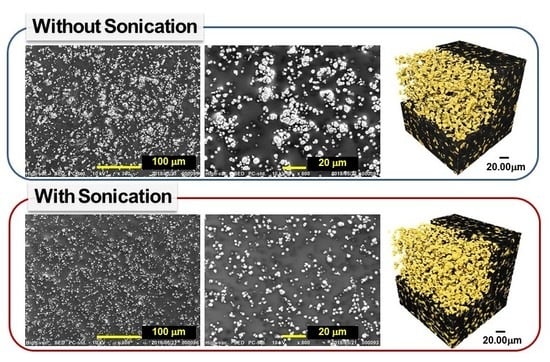Effect of Sonication Time on Magnetorheological Effect for Monomodal Magnetic Elastomers
Abstract
:1. Introduction
2. Results and Discussion
3. Conclusions
4. Materials and Methods
4.1. Synthesis of Magnetic Elastomer
4.2. Rheological Measurements
4.3. SEM Observations
4.4. CT Scan Observations
Author Contributions
Acknowledgments
Conflicts of Interest
References
- Weeber, R.; Hermes, M.; Schmidt, A.M.; Holm, C. Polymer architecture of magnetic gels: A review. J. Phys. Condens. Matter 2018, 20, 063002. [Google Scholar] [CrossRef] [PubMed]
- Sutrisno, J.; Purwanto, A.; Mazlan, S.A. Recent Progress on Magnetorheological Solids: Materials, Fabrication, Testing, and Applications. Adv. Eng. Mater. 2015, 17, 563–597. [Google Scholar]
- Nguyen, V.Q.; Ahmed, A.S.; Ramanujan, R.V. Morphing Soft Magnetic Composites. Adv. Mater. 2012, 24, 4041–4054. [Google Scholar] [CrossRef] [PubMed]
- Chertovich, A.V.; Stepanov, G.V.; Kramarenko, E.Y.; Khokhlov, A.R. New Composite Elastomers with Giant Magnetic Response. Macromol. Mater. Eng. 2010, 295, 336–341. [Google Scholar] [CrossRef]
- Mitsumata, T.; Ohori, S. Magnetic polyurethane elastomers with wide range modulation of elasticity. Polym. Chem. 2011, 2, 1063–1067. [Google Scholar] [CrossRef]
- Mitsumata, T.; Ohori, S.; Honda, A.; Kawai, M. Magnetism and viscoelasticity of magnetic elastomers with wide range modulation of dynamic modulus. Soft Matter 2013, 9, 904–912. [Google Scholar] [CrossRef]
- Nanpo, J.; Nagashima, K.; Umehara, Y.; Kawai, M.; Mitsumata, T. Magnetic-Field Sensitivity of Storage Modulus for Bimodal Magnetic Elastomers. J. Phys. Chem. B 2016, 120, 12993–13000. [Google Scholar] [CrossRef] [PubMed]
- Lee, S.; Yim, C.; Kim, W.; Jeon, S. Magnetorheological Elastomer Films with Tunable Wetting and Adhesion Properties. ACS Appl. Mater. Interfaces 2015, 7, 19853–19856. [Google Scholar] [CrossRef] [PubMed]
- Drotlef, D.-M.; Blümler, P.; Papadopoulos, P.; Campo, A. Magnetically Actuated Micropatterns for Switchable Wettability. ACS Appl. Mater. Interfaces 2014, 6, 8702–8707. [Google Scholar] [CrossRef] [PubMed]
- Wang, Y.; Xuan, S.; Ge, L.; Wen, Q.; Gong, X. Conductive magnetorheological elastomer: Fatigue dependent impedance-mechanic coupling properties. Smart Mater. Struct. 2017, 26, 015004. [Google Scholar] [CrossRef]
- Sasaki, S.; Tsujiei, Y.; Kawai, M.; Mitsumata, T. Electric Conductivity and Dielectric-Breakdown Behavior for Polyurethane Magnetic Elastomers. J. Phys. Chem. B 2017, 121, 1740–1747. [Google Scholar] [CrossRef] [PubMed]
- Shin, J.; Kang, M.; Tsai, T.; Leal, C.; Braun, P.V.; Cahill, D.G. Thermally Functional Liquid Crystal Networks by Magnetic Field Driven Molecular Orientation. ACS Macro Lett. 2016, 5, 955–960. [Google Scholar] [CrossRef]
- Yuan, F.; Jiao, W.; Yang, F.; Liu, W.; Xu, Z.; Wang, R. Surface modification and magnetic alignment of hexagonal boron nitride nanosheets for highly thermally conductive composites. RSC Adv. 2017, 7, 43380–43389. [Google Scholar] [CrossRef]
- Lee, D.; Kwon, O.; Song, S. Tailoring the performance of magnetic elastomers containing Fe2O3 decorated carbon nanofiber. RSC Adv. 2017, 7, 45595–45600. [Google Scholar] [CrossRef]
- Chen, D.; Yu, M.; Zhu, M.; Qi, S.; Fu, J. Carbonyl iron powder surface modification of magnetorheological elastomers for vibration absorbing application. Smart Mater. Struct. 2016, 25, 115005. [Google Scholar] [CrossRef]
- Behrooz, M.; Sutrisno, J.; Zhang, L.Y.; Fuchs, A.; Gordaninejad, F. Behavior of magnetorheological elastomers with coated particles. Smart Mater. Struct. 2015, 24, 035026. [Google Scholar] [CrossRef]
- Mohammadi, A.; Barikani, M.; Barmar, M. Effect of surface modification of Fe3O4 nanoparticles on thermal and mechanical properties of magnetic polyurethane elastomer nanocomposites. J. Mater. Sci. 2013, 48, 7493–7502. [Google Scholar] [CrossRef]
- Qiao, X.Y.; Lu, X.S.; Li, W.H.; Chen, J.; Gong, X.L.; Yang, T.; Li, W.; Sun, K.; Chen, X.D. Microstructure and magnetorheological properties of the thermoplastic magnetorheological elastomer composites containing modified carbonyl iron particles and poly(styrene-b-ethylene-ethylenepropylene-b-styrene) matrix. Smart Mater. Struct. 2012, 21, 115028. [Google Scholar] [CrossRef]
- Evans, B.A.; Fiser, B.L.; Prins, W.J.; Rapp, D.J.; Shields, A.R.; Glass, D.R.; Superfine, R. A highly tunable silicone-based magnetic elastomer with nanoscale homogeneity. J. Magn. Magn. Mater. 2012, 324, 501–507. [Google Scholar] [CrossRef] [PubMed]
- Montazeri, A.; Montazeri, N.; Pourshamsian, K.; Tcharkhtchi, A. The Effect of Sonication Time and Dispersing Medium on the Mechanical Properties of Multiwalled Carbon Nanotube (MWCNT)/Epoxy Composite. Int. J. Polym. Anal. Charact. 2011, 16, 456–476. [Google Scholar] [CrossRef]
- Cividanes, L.; Simonetti, E.; Oliveira, J.; Serra, A.; Barboza, J.; Thim, G. The Sonication Effect on CNT-Epoxy Composites Finally Clarified. Polym. Compos. 2017, 38, 1964–1973. [Google Scholar] [CrossRef]
- Tarawneh, M.; Ahmad, S.; EhNoum, S.; Lau, K. Sonication effect on the mechanical properties of MWCNTs reinforced natural rubber. J. Compos. Mater. 2013, 47, 579–585. [Google Scholar] [CrossRef]
- Lam, C.; Lau, K.; Cheung, H.; Ling, H. Effect of ultrasound sonication in nanoclay clusters of nanoclay/epoxy composites. Mater. Lett. 2005, 59, 1369–1372. [Google Scholar] [CrossRef]
- Kabir, M.E.; Saha, M.C.; Jeelani, S. Effect of ultrasound sonication in carbon nanofibers/polyurethane foam composite. Mater. Sci. Eng. A 2007, 459, 111–116. [Google Scholar] [CrossRef]
- Cheng, Q.; Debnath, S.; Gregan, E.; Byrne, H.J. Ultrasound-assisted SWNTs dispersion: Effects of sonication parameters and solvent properties. J. Phys. Chem. C 2010, 114, 8821–8827. [Google Scholar] [CrossRef]
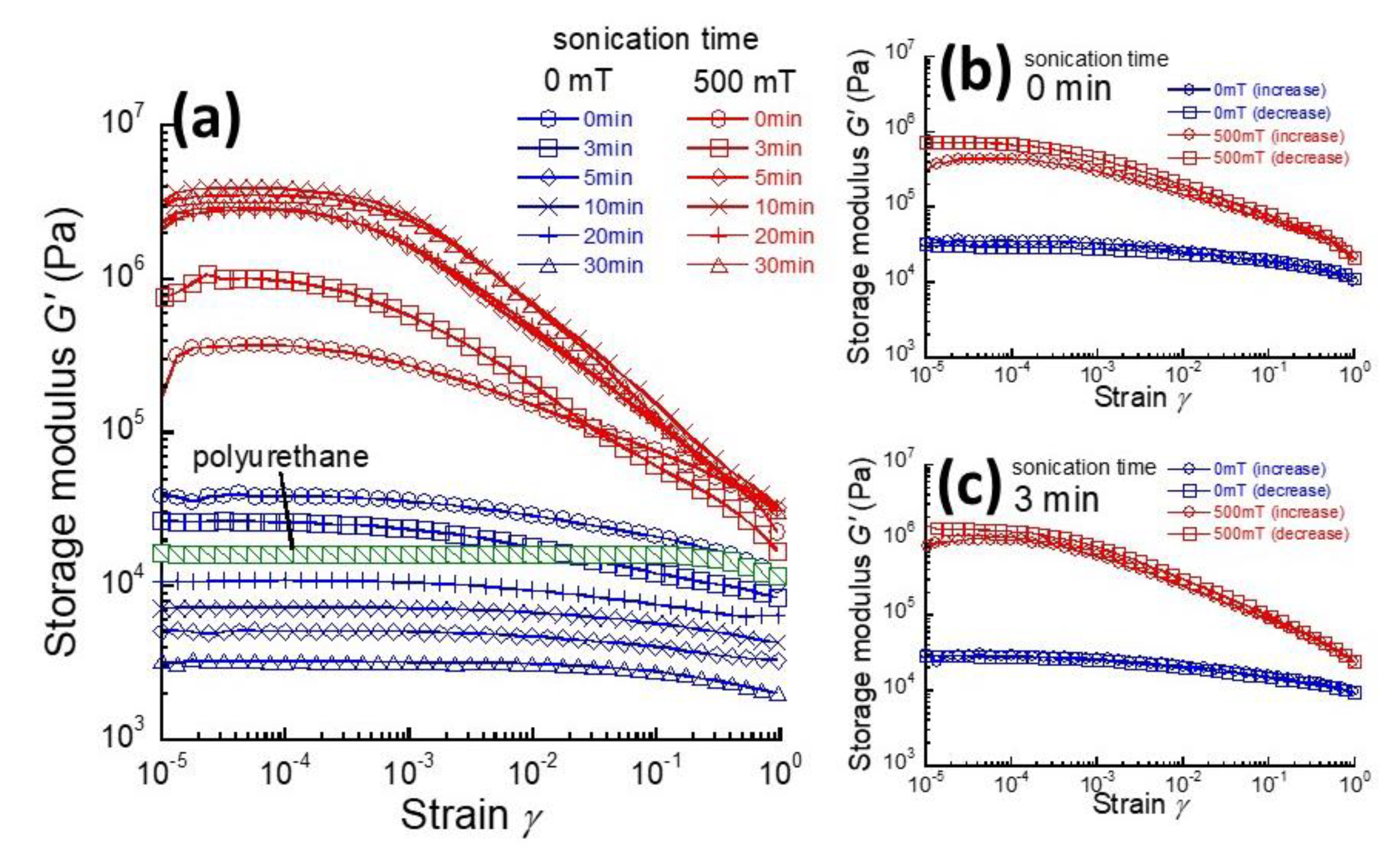

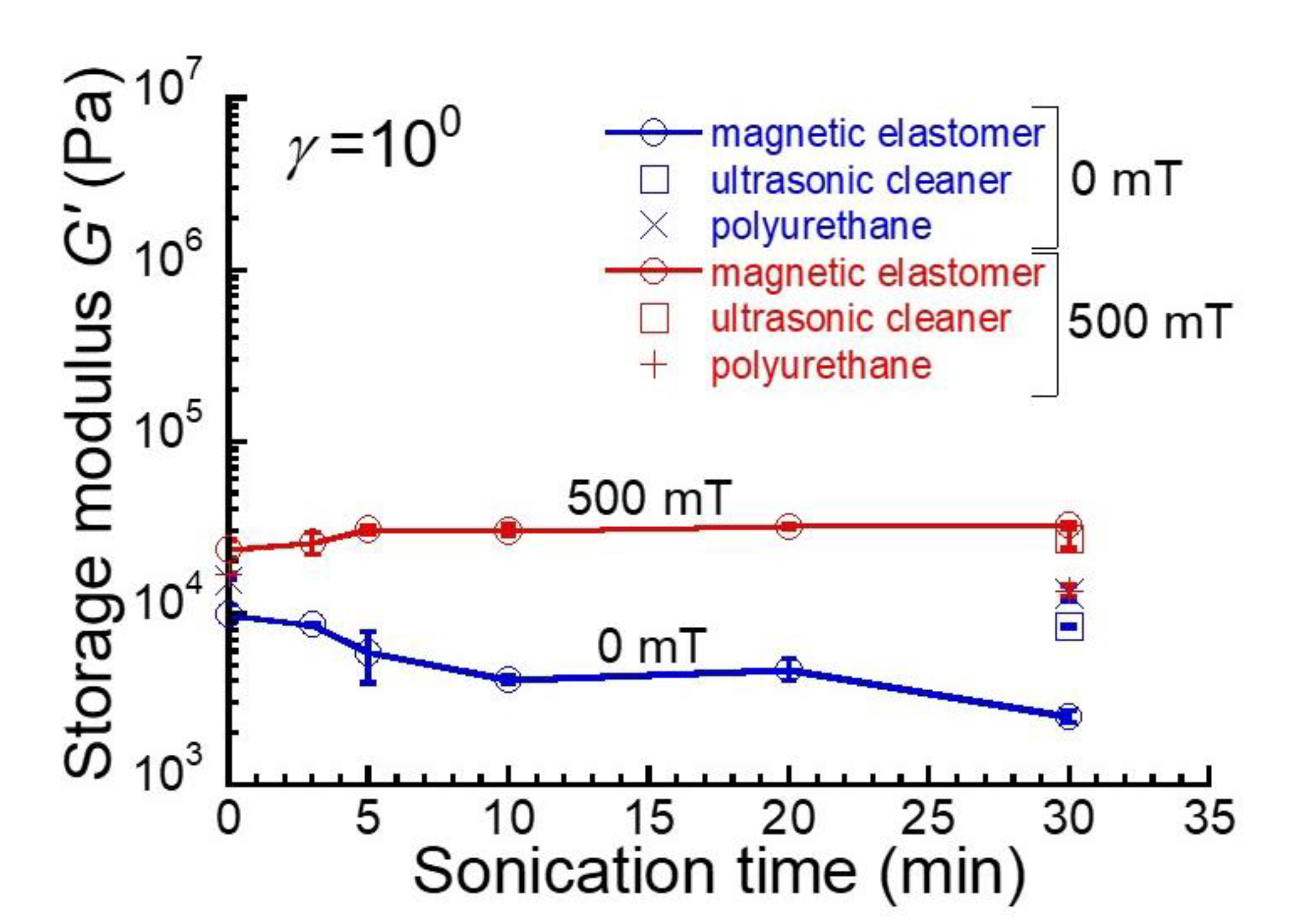
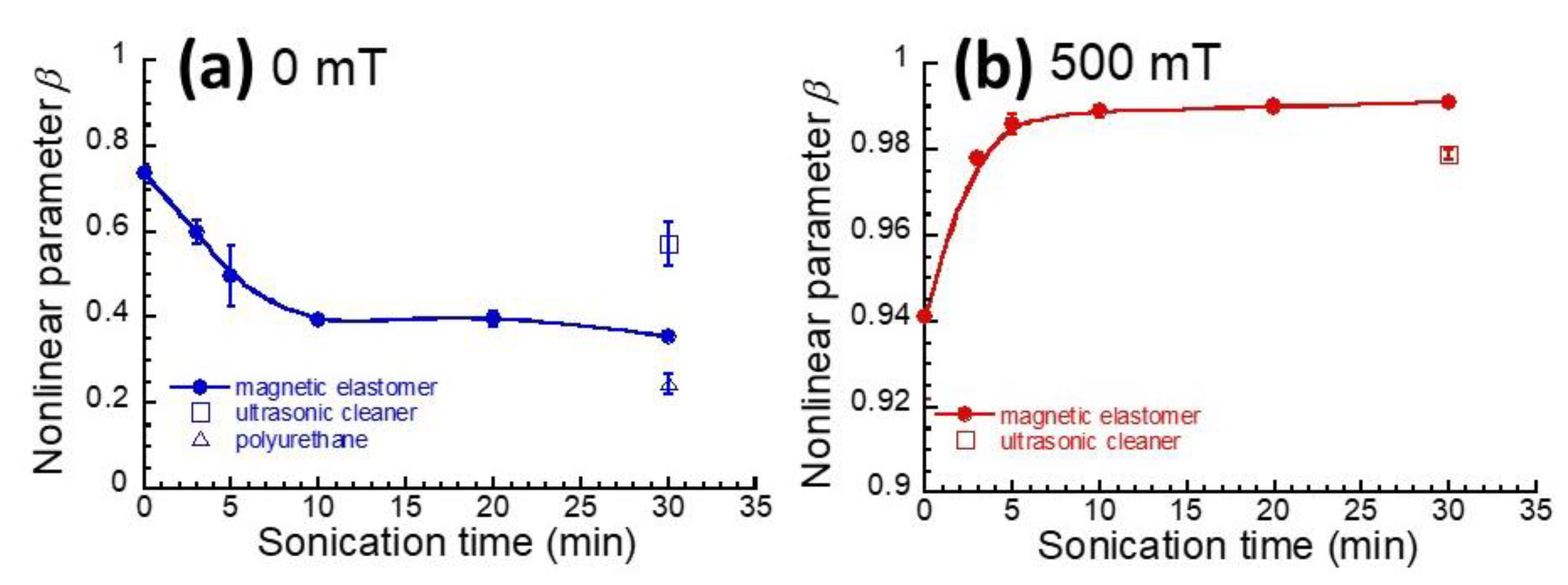
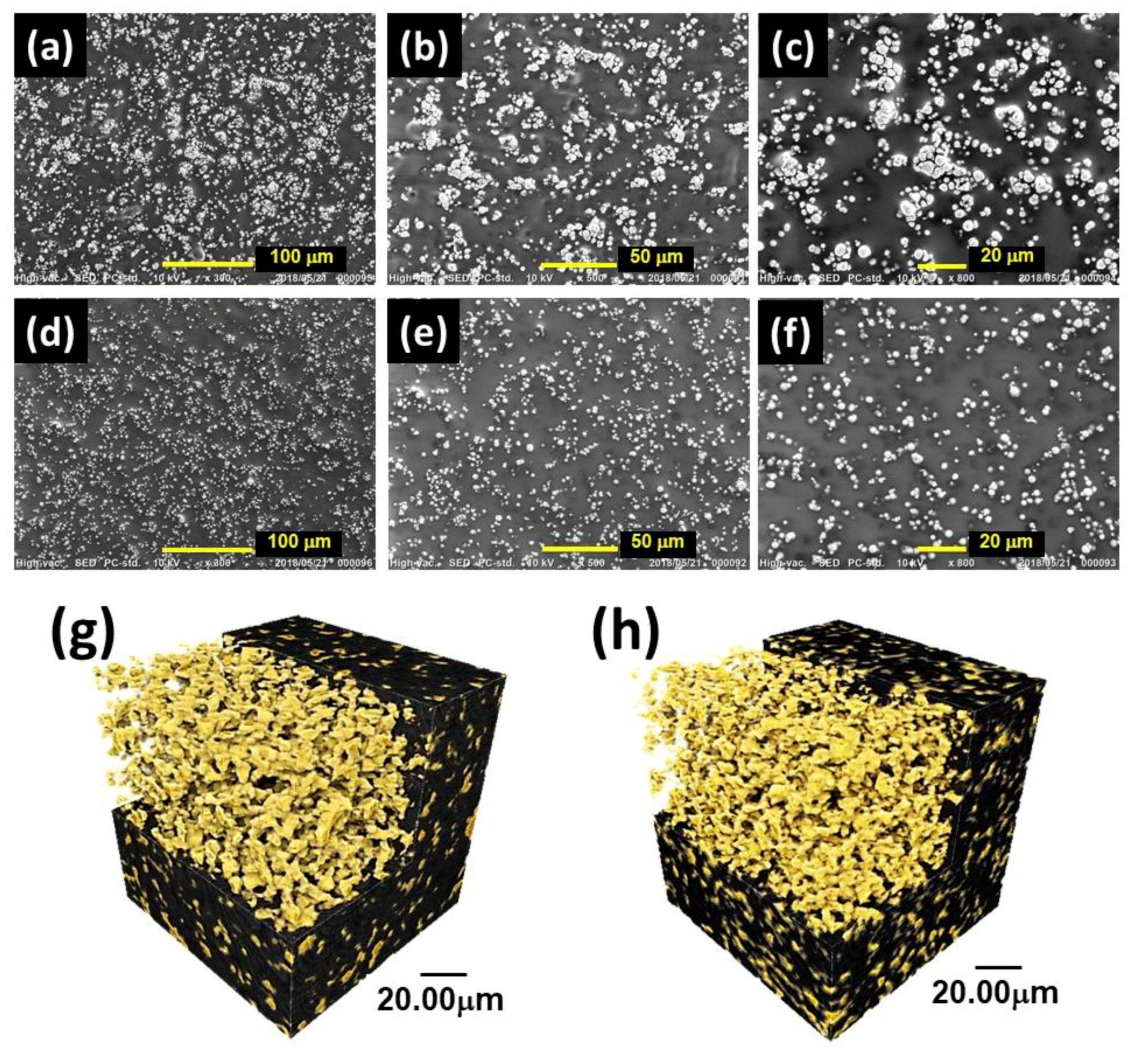
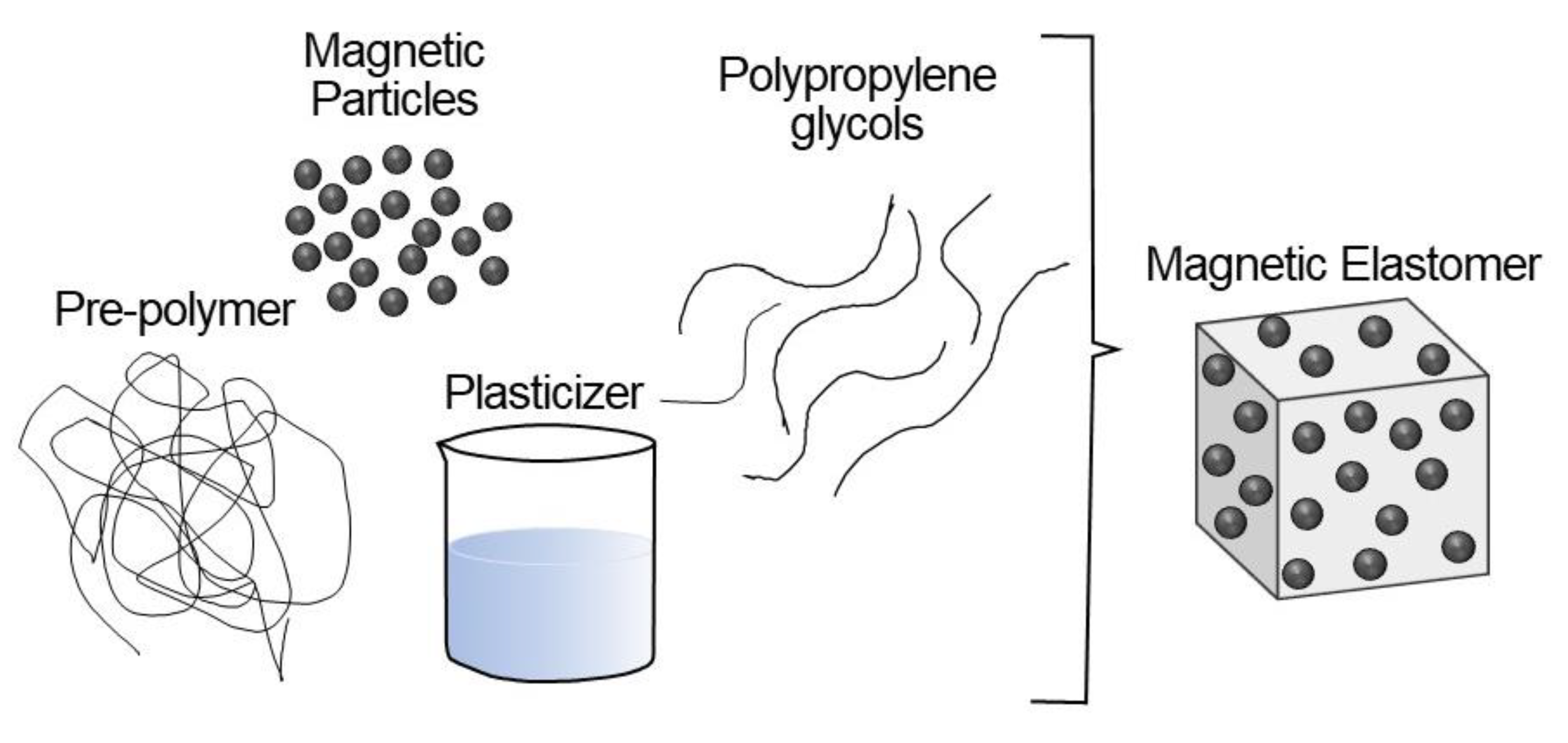
© 2018 by the authors. Licensee MDPI, Basel, Switzerland. This article is an open access article distributed under the terms and conditions of the Creative Commons Attribution (CC BY) license (http://creativecommons.org/licenses/by/4.0/).
Share and Cite
Watanabe, M.; Ikeda, J.; Takeda, Y.; Kawai, M.; Mitsumata, T. Effect of Sonication Time on Magnetorheological Effect for Monomodal Magnetic Elastomers. Gels 2018, 4, 49. https://doi.org/10.3390/gels4020049
Watanabe M, Ikeda J, Takeda Y, Kawai M, Mitsumata T. Effect of Sonication Time on Magnetorheological Effect for Monomodal Magnetic Elastomers. Gels. 2018; 4(2):49. https://doi.org/10.3390/gels4020049
Chicago/Turabian StyleWatanabe, Mayuko, Junko Ikeda, Yoshihiro Takeda, Mika Kawai, and Tetsu Mitsumata. 2018. "Effect of Sonication Time on Magnetorheological Effect for Monomodal Magnetic Elastomers" Gels 4, no. 2: 49. https://doi.org/10.3390/gels4020049





